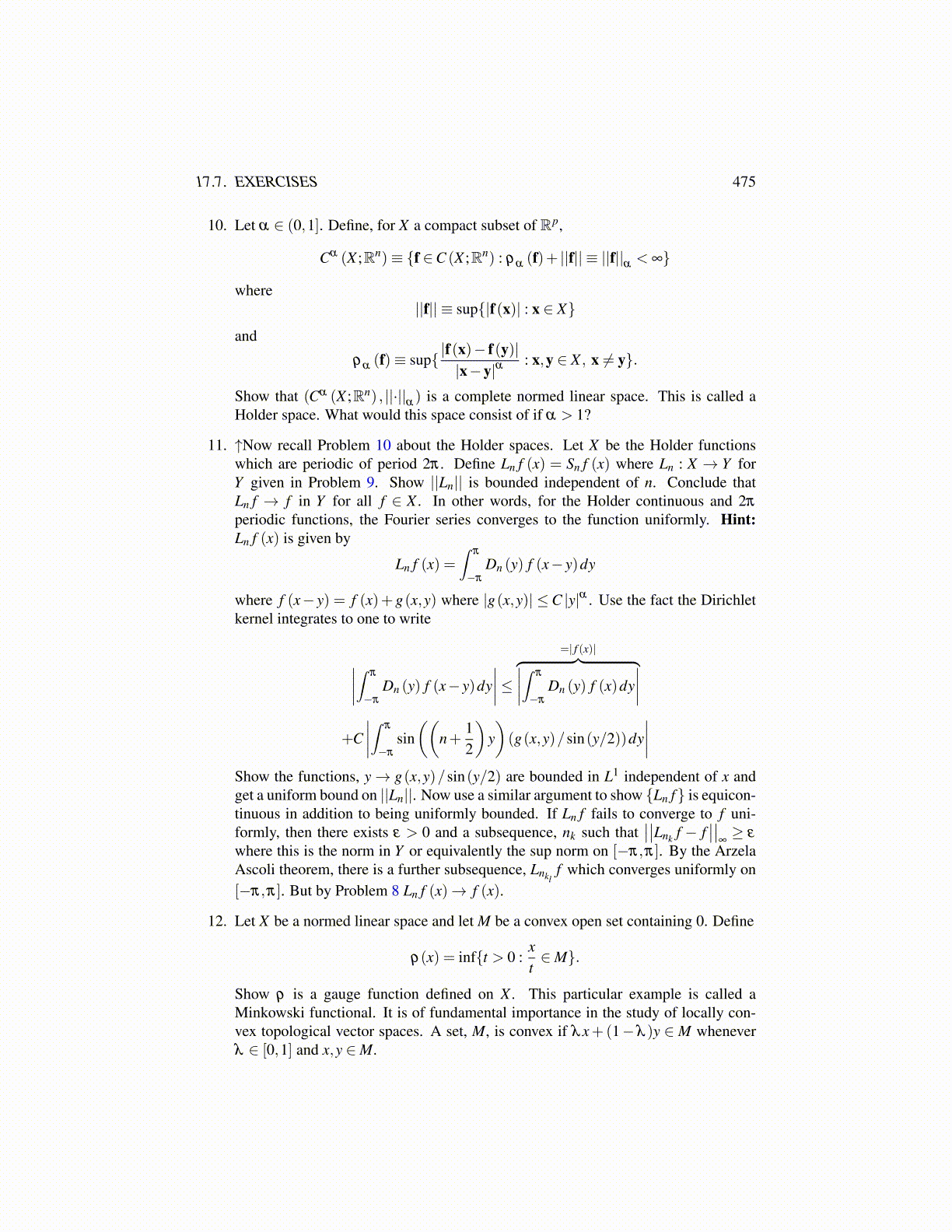
17.7. EXERCISES 475
10. Let α ∈ (0,1]. Define, for X a compact subset of Rp,
Cα (X ;Rn)≡ {f ∈C (X ;Rn) : ρα (f)+ ||f|| ≡ ||f||α< ∞}
where||f|| ≡ sup{|f(x)| : x ∈ X}
and
ρα (f)≡ sup{ |f(x)− f(y)||x−y|α
: x,y ∈ X , x ̸= y}.
Show that (Cα (X ;Rn) , ||·||α) is a complete normed linear space. This is called a
Holder space. What would this space consist of if α > 1?
11. ↑Now recall Problem 10 about the Holder spaces. Let X be the Holder functionswhich are periodic of period 2π . Define Ln f (x) = Sn f (x) where Ln : X → Y forY given in Problem 9. Show ||Ln|| is bounded independent of n. Conclude thatLn f → f in Y for all f ∈ X . In other words, for the Holder continuous and 2π
periodic functions, the Fourier series converges to the function uniformly. Hint:Ln f (x) is given by
Ln f (x) =∫
π
−π
Dn (y) f (x− y)dy
where f (x− y) = f (x)+g(x,y) where |g(x,y)| ≤C |y|α . Use the fact the Dirichletkernel integrates to one to write
∣∣∣∣∫ π
−π
Dn (y) f (x− y)dy∣∣∣∣≤
=| f (x)|︷ ︸︸ ︷∣∣∣∣∫ π
−π
Dn (y) f (x)dy∣∣∣∣
+C∣∣∣∣∫ π
−π
sin((
n+12
)y)(g(x,y)/sin(y/2))dy
∣∣∣∣Show the functions, y→ g(x,y)/sin(y/2) are bounded in L1 independent of x andget a uniform bound on ||Ln||. Now use a similar argument to show {Ln f} is equicon-tinuous in addition to being uniformly bounded. If Ln f fails to converge to f uni-formly, then there exists ε > 0 and a subsequence, nk such that
∣∣∣∣Lnk f − f∣∣∣∣
∞≥ ε
where this is the norm in Y or equivalently the sup norm on [−π,π]. By the ArzelaAscoli theorem, there is a further subsequence, Lnkl
f which converges uniformly on[−π,π]. But by Problem 8 Ln f (x)→ f (x).
12. Let X be a normed linear space and let M be a convex open set containing 0. Define
ρ(x) = inf{t > 0 :xt∈M}.
Show ρ is a gauge function defined on X . This particular example is called aMinkowski functional. It is of fundamental importance in the study of locally con-vex topological vector spaces. A set, M, is convex if λx+(1−λ )y ∈M wheneverλ ∈ [0,1] and x,y ∈M.